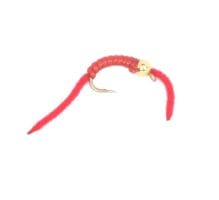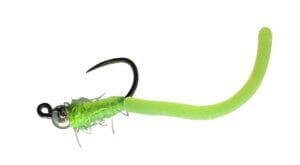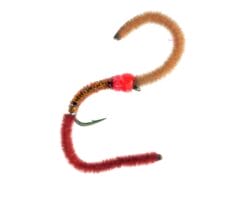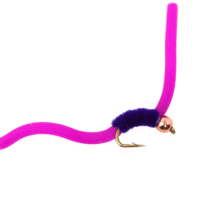Your cart is currently empty!
Red Beadhead San Juan Worm
Product Overview and Heritage?The Red Beadhead San Juan Worm represents an evolution of the classic San Juan Worm pattern, featuring a unique combination of traditional worm imitation with modern beadhead construction. This specialized pattern incorporates high-visibility red materials with precise tying methods, making it particularly effective for imitating aquatic worms and annelids while providing enhanced…
Description
Product Overview and Heritage?The Red Beadhead San Juan Worm represents an evolution of the classic San Juan Worm pattern, featuring a unique combination of traditional worm imitation with modern beadhead construction. This specialized pattern incorporates high-visibility red materials with precise tying methods, making it particularly effective for imitating aquatic worms and annelids while providing enhanced sink rates through its beadhead design. Originally developed on the San Juan River in New Mexico, this pattern has become a standard choice for serious anglers, consistently producing results in demanding situations, especially during high water conditions.
Design Features and Materials?Hook Characteristics:
- Premium scud hook
- Available sizes: 12-16
- Standard wire construction
- Wide gap design
- Chemically sharpened point
- Bronze finish
- Optimal hook strength
- Enhanced penetration design
- Perfect size-to-weight ratio
- Freshwater durability
Material Components:
- Brass/tungsten bead
- Red ultra chenille
- Thread base
- Enhanced durability
- Modern materials
- Simple construction
- Color-fast characteristics
- Movement enhancement
- Natural appearance
- Quick-sinking design
Construction and Tying Process?The pattern’s success relies on precise construction methods:
- Balanced proportions
- Strategic bead placement
- Proper chenille length
- Reinforced connections
- Material integration
- Enhanced durability features
- Clean thread base
- Proper segmentation
- Profile consistency
- Movement optimization
Fishing Applications and Techniques?Presentation Methods:
- Dead drift
- Slight twitches
- Multiple angles
- Depth control
- Pattern placement
- Current fishing
- Structure targeting
- Cross-current drifts
- Action variation
- Traditional methods
Specialized Applications:
- High water conditions
- Post-rain fishing
- Muddy water
- Clear conditions
- Low light periods
- Morning fishing
- Search pattern
- Active fish
- High-pressure situations
- Technical water
Seasonal Effectiveness?Spring Performance:
- Early season success
- Mixed techniques
- Weather changes
- Pattern selection
- Temperature increases
- Fish movement
- Feeding windows
- Natural cycles
- Light conditions
- Runoff periods
Summer Strategy:
- Deep water fishing
- Morning/evening peaks
- Temperature adaptation
- Feeding patterns
- Oxygen levels
- Light penetration
- Fish behavior
- Water conditions
- Current seams
- Structure targeting
Fall Applications:
- Pre-winter feeding
- Cooling waters
- Changed light conditions
- Transitional periods
- Selective takes
- Pattern visibility
- Fish location
- Temperature drops
- Migration patterns
- Feeding windows
Habitat and Water Types?Water Applications:
- Rivers and streams
- Deep runs
- Fast water
- Clear water
- Turbid conditions
- Structure areas
- Current seams
- Drop-offs
- Holding water
- Pocket water
Specialized Environments:
- Various waters
- Technical streams
- High gradient waters
- Complex currents
- Bank edges
- Deep riffles
- Different streams
- Pool heads
- Current breaks
- Fast water
Target Species and Behavior?Primary Species:
- Brown Trout
- Rainbow Trout
- Brook Trout
- Steelhead
- Multiple Species
- Selective Feeders
- Deep-water Feeders
- Technical Fish
Behavioral Patterns:
- Bottom feeding
- Selective takes
- Pattern recognition
- Natural behavior
- Opportunistic strikes
- Selective periods
- Strike triggers
- Visual stimulation
- Lateral line response
- Competitive behavior
Rigging Recommendations?Leader Setup:
- 9-12 foot leaders
- 4X-6X tippet
- Tapered leaders
- Fluorocarbon options
- Loop-to-loop connections
- Proper presentation
- Adequate stiffness
- Knot strength
- Breaking strain
- Abrasion resistance
Presentation Options:
- Single worm
- Double nymph rigs
- Traditional methods
- Modern techniques
- Line matching
- Leader design
- Tippet selection
- Depth control
- Drift adjustment
- Action variation
Professional Applications?Guide Usage:
- Client-friendly pattern
- Proven success rates
- Consistent performance
- Easy presentation
- Multiple techniques
- Teaching tool
- Confidence pattern
- Versatile applications
- Durability
- Hook-up ratio
Competition Usage:
- Tournament proven
- Technical water success
- Pressure adaptation
- Quick-change capability
- Consistent performance
- Pattern rotation
- Size variation
- Color selection
- Presentation options
- Result tracking
Advanced Technical Applications?The Red Beadhead San Juan Worm excels in specific technical situations that require precise presentation and depth control. When fishing high-water conditions, the pattern performs exceptionally well in the following scenarios:
- Deep runs with depths of 3-8 feet
- Transition zones between fast and slow water
- Areas with silty or muddy bottoms
- Undercut banks during high water
- Complex current seams in tailwater situations
The pattern’s effectiveness can be enhanced through specialized presentation techniques:
- Short-line nymphing with minimal indicator use
- Tension-based strike detection in fast water
- Micro-adjustments to depth using tippet length
- Strategic mending for optimal drift control
- Counter-current presentation in complex flows
Water temperature significantly impacts the pattern’s effectiveness:
- Optimal performance in 45-65?F range
- Increased activity during warming trends
- Enhanced success during stable barometric conditions
- Peak effectiveness during morning temperature transitions
- Adapted presentation based on metabolic activity
Care and Maintenance?Post-Fishing Care:
- Thorough drying
- Material grooming
- Hook inspection
- Chenille maintenance
- Material preservation
- Storage preparation
- Pattern inspection
- Shape verification
- Performance testing
- Movement checking
Storage Requirements:
- Dry environment
- UV protection
- Separate compartments
- Regular inspection
- Moisture prevention
- Temperature control
- Light protection
- Ventilation needs
- Box organization
- Inventory management
Environmental Considerations?Conservation Features:
- Sustainable materials
- Durable construction
- Catch-and-release friendly
- Minimal environmental impact
- Eco-conscious design
- Material selection
- Ethical considerations
- Resource protection
- Species conservation
- Environmental awareness
Material Selection:
- Responsible sourcing
- Quality components
- Mixed elements
- Ethical production
- Sustainable practices
- Environmental impact
- Material longevity
- Waste reduction
- Local materials
- Eco-conscious design
Additional information
| Hook type | Barbed Hooks, Barbless Hooks |
|---|---|
| Hook size | 10, 12, 14, 16, 18, 20 |







